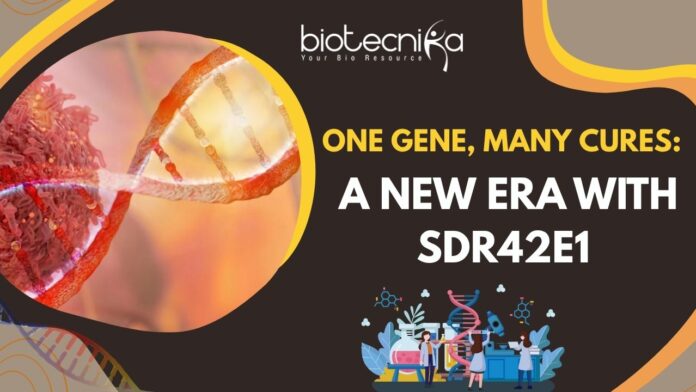Table of Contents
Cancer Treatment Revolution – SDR42E1 Gene Discovery
Scientists have made an exciting discovery — a gene called SDR42E1. This gene helps the body absorb Vitamin D and may pave the way for new treatments for autoimmune diseases and cancer. The finding opens new possibilities for precision medicine, which targets cancer cells while protecting healthy tissues.
An Important Gene in Vitamin D Metabolism – SDR42E1
The SDR42E1 gene belongs to the SDR (Short-Chain Dehydrogenase/Reductase) superfamily. Recent research highlights SDR42E1 as a key regulator of vitamin D activation and absorption. Scientists emphasize that SDR42E1 enables vitamin D absorption in the intestines and converts it into Calcitriol, the active hormonal form of Vitamin D. Calcitriol supports immune function, cellular health, and bone strength.
Researchers using CRISPR/Cas9 Gene Editing Technology discovered that mutating or inactivating SDR42E1 creates a non-functional protein. This disruption severely limits the body’s ability to process vitamin D. As a result, some individuals remain vitamin D deficient even after taking supplements
or receiving adequate sunlight. The discovery underlines SDR42E1’s critical role in personalized nutrition, the cancer treatment revolution, and overall health.Molecular Docking and Evolutionary Insights
To understand SDR42E1’s function better, researchers performed molecular docking studies. Their analysis showed that the gene product strongly binds to Vitamin D₃ and its precursors 7-dehydrocholesterol and 8-dehydrocholesterol. These molecules play key roles in the skin’s vitamin D synthesis, suggesting that SDR42E1 also contributes to vitamin D biosynthesis at the skin level.
Scientists also found that the gene remains evolutionarily conserved across species — from humans to fruit flies — highlighting its vital role in sterol metabolism. When researchers silenced SDR42E1, the expression of more than 4,600 genes changed. These alterations likely affect oncogenic signaling pathways, lipid metabolism, and sterol absorption.
The Gene-Editing Technology Behind the Innovation – CRISPR/Cas9
Central to this breakthrough is the use of CRISPR/Cas9 (Clustered Regularly Interspaced Short Palindromic Repeats-associated protein 9). This is a well-known Gene Editing Technology that allows precise modification of DNA. CRISPR is adapted from bacterial immune defense systems. It works by utilizing a gRNA (guide RNA ) to locate the target Gene Sequence. At the exact moment, the Cas9 enzyme acts like molecular scissors, thereby cutting the DNA at the particular/designated site. This system aids scientists in either correcting a gene’s function by inserting a template DNA or disrupting a gene’s function.
The Researchers applied this advanced technology to knock out the SDR42E1 gene and further study its effects on Cellular processes, especially in colorectal cancer cells, the site where the gene is highly active.
Striking Effects in Colorectal Cancer Cells
In Research utilizing HCT116 colorectal cancer cells, inactivation of the SDR42E1 gene resulted in a 53% reduction in cell viability. This implied that this gene is quite essential for the survival of cancerous cells. This sensitivity can be utilized for targeted cancer cell Therapeutics.
Further analysis showcased that disabling the SDR42E1 gene disrupted multiple Molecular pathways in the body, such as:
- Proteomic Analysis revealed a marked reduction in ALDOA, a major protein in cellular proliferation and metabolism.
- Downregulated genes include SLC7A5 and WNT16, both of which are implicated in nutrient transport and cancer progression.
- Upregulated genes, LRP1B, a tumor suppressor, and ABCC2, involved in drug resistance.
Interestingly, when SDR2E1 was transiently overexpressed, some of these changes were reversed. For instance, there was a restoration of ABCC2 levels as well as cancer cell viability. This suggests a Dose-Dependent Effect and potential for fine-tuned therapeutics strategies.
Implications for Cancer and Autoimmune Disease Treatment
The ability to selectively target SDR42E1 in cancer cells, while sparing normal, healthy tissue, offers a promising direction for precision oncology. Since the gene has such wide-ranging effects on sterol metabolism and immune-related pathways, it could also become a novel target in autoimmune disease therapies. This is especially relevant where vitamin D plays a well-established immunomodulatory role.
Although the research is still in the Preclinical Stages, the data are compelling. The team emphasizes the need for further Research, as well as Clinical Trials, to validate SDR42E1-targeting drugs or gene therapies. However, this research opens new avenues for Personalized Medicine, especially for patients with resistant or chronic Vitamin D deficiency syndromes.
This new insight into the role of Cancer Treatment Revolution SDR42E1 in vitamin D metabolism and its connection to cancer cell survival represents a significant advancement. It advances our understanding of gene function, nutrient absorption, and disease progression. As gene-editing tools like CRISPR/Cas9 continue to evolve, the possibility of designing custom therapies that strike at the genetic root of disease becomes ever more tangible. This brings us closer to a future where cancer and autoimmune diseases could be not just treated, but potentially cured.
































internship purpose for this msg